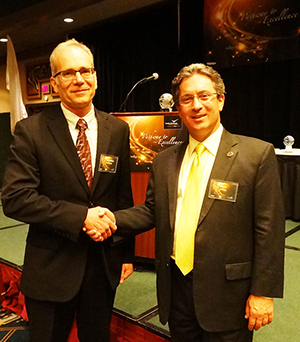IIC Scientist Exemplifies the Three Ds of Research
Patent proliferation leads to Distinguished Inventor Award for IIC associate director
Catalysis breakthroughs rely on the three Ds: discovery, development, and deployment. Discoveries such as how to break the chemical bonds in feedstocks to remove sulfur. Developments such as turning fermentation liquids into fuels and chemicals. And deployment, when the combined efforts of discovery and development result in a usable product or method, such as replacing petroleum-based coatings and polymers with ones derived from biomass.

John Holladay (left) receiving the Battelle Distinguished Inventor Award from Steve Ashby, director of Pacific Northwest National Laboratory.
Institute for Integrated Catalysis (IIC) associate director John Holladay added another D to the mix in 2015 when he was named a Battelle Distinguished Inventor at Pacific Northwest National Laboratory. This title is given to staff credited with 14 or more U.S. patents as a direct result of their work for Battelle, which operates PNNL for the U.S. Department of Energy.
Holladay, who oversees PNNL's research portfolio on biofuels, products, and energy, has earned 17 patents in the area of catalysis and chemistry related to bio-based processing. These technologies have been licensed to at least eight companies, demonstrating their practical value.
"John has contributed over many years at PNNL to new and innovative technologies in bioproducts and chemical processing," said Ron Thomas, a PNNL commercialization manager. "His research contributions over the years have ranged from sustainable use of terrestrial biomass and marine systems to fuels and chemicals via chemical and biological catalysis."
In particular, the patents awarded to Holladay—and his colleagues for processes related to hydrogenolysis, or how to break carbon-carbon and carbon-oxygen bonds selectively, have been commercialized and are in practice today.
One of their best examples is creating propylene glycol from glycerol. Or their work on hybrid biotechnologies, where catalysis is used on fermentation broths to make important chemicals. "We start from sugars, fermentation broths, or byproducts from other processes and use them as feedstock," Holliday said.
They have also patented unique processes that enable catalysis in the presence of the unique impurities, or "poisons" in biomass. "Catalysts used with hydrocarbons have oxygen; biomass has sugars, which are a whole different kind of poison," said Holladay. "They require either whole different families of catalysts that are stable under hydrothermal conditions, and in the presence of impurities. Or you have to develop processes to run catalytic process in presence of these unique impurities."
Most of Holladay's 17 patents are for taking widely used chemicals traditionally made from petroleum or acrylates and making them instead with renewable resources, resulting in a lower carbon footprint. Similarly, Holladay and colleagues have made new biomass-derived compounds that can go into coatings and polymers, but bring different chemical properties to the materials than fossil-based ones.
Holladay is among many researchers at DOE's national laboratories who perform fundamental science and applied research in catalysis leading to advancements that ultimately are put to use to make energy cleaner, safer, and more abundant.

